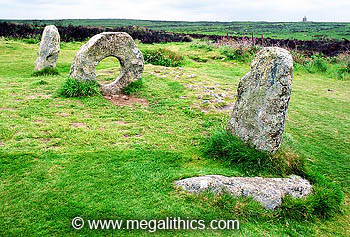
 |
|
Photo Gallery |
|
|
VR Panoramas |
|
|
|
Infrared |
|
|
|
Antiquarian |
|
| SW 42653 34950 (GPS 15min) | |
| Visited August 1991/June 2000 | No magnetic anomalies |
The Men-an-Tol in its present form is a
unique monument, there are no other holed stones in comparable alignments in the
UK. The name is Cornish for "holed stone", although the individual
holed stone is also known as the "Crick Stone" or the "Devil's
Eye".
The arrangement of stones that you see today is almost certainly not original,
as late as 1754 William Borlase (1) drew a plan of the site showing the stones in a
triangular formation. Recent investigations suggest that the monument may have
originally been a stone circle, evidence was found for eleven stones from a
projected nineteen to twenty. Even a cursory glance at the site shows a fallen
stone near the western upright, two more a few metres to the west, and an area
of small exposed stones around the holed stone itself looks suspiciously like
the remains of a cairn. These findings are somewhat at odds with Hencken's1932
account (2) of the monument, he discounted the extra stones at the site as
having "lately been moved about and certainly represent no ancient
structure", he also saw the holed stone itself as "the solitary
survivor of a destroyed tomb."
When we first visited in 1991 it was difficult to find, being buried in gorse
and bracken on the moor, in 2000 we were surprised to see signposts, neatly cut
grass, and pathways to the site, it seems that it has become quite a tourist
attraction. Unfortunately this popularity is not without its downside, recently
someone tried to destroy the Men-an-Tol by covering it with a homemade napalm
mixture and setting it on fire. Fortunately the stones survived the ordeal, but
the residue from the attack still thickly coats some parts of the stones and is
easily visible in our photos and panoramas.
William Borlase (1) visited the Men an Tol
in 1749 and was told of its uses by "a very intelligent farmer of the
neighbourhood", the Men an Tol seems to have been a veritable Swiss Army
Knife of paranormal cure and divination. Borlase was told of the
"many persons who had crept through this holed Stone for pains in their
back and limbs" and also that "fanciful parents, at certain times of
the year, do customarily draw their young Children through in order to cure them
of Rickets." The farmer also showed him "two brass pins, carefully
layed a-cross each other" on the top of the stone, placed there by the
"Over-curious" and that by "recurring to these pins, and
observing their direction to be the same, or different from what they left them
in, or by their being lost or gone, they are informed of some material incident
of Love or Fortune, which they could not know soon enough in a natural
way".
Borlase was not convinced by these accounts and had his own theories about how
the "Cornish Druids" used the holed stone, "I apprehend that it
served for Libations, served to initiate, and dedicate Children to the Offices
of Rock-Worship, by drawing them through this hole, and also to purify the
Victim before it was sacrificed".
One hundred and sixty years later, Hencken (2) was told by a local farmer that
his grandfather remembered people using the Men an Tol as a cure for aches and
pains, and that "the stone is locally called the Crickstone because people
crawled through it for a crick in the back".
It seem as though superstition may have saved the Men an Tol from an ignominious end, as W.C.Borlase (3) tells us of the fate of many chambered cairns near by. "On the downs lying between Morvah hill barrow, and the Men-an-Tol, or famous holed stone, were a large number of these graves, until their granite sides and covers were, a few years since, carried away to make some waterfalls in the gardens at Castle Horneck."
UPDATE. We have recently (2003), been informed that the residue from the burning compound has now been removed from the stones. Unfortunately we did not have time to revisit the site this year so there are no photos of the cleaned stones, but the Men an Tol should now look much more attractive without the residue of the vandalism.
(1) Borlase W. Antiquities Historical and
Monumental of the County of Cornwall, Bowyer and Nichols, London 1769
(2) Hencken H.O. The Archaeology of Cornwall and Scilly, Metheun, London, 1932
(3) Borlase W.C., Naenia Cornubiae p78, 1872 Longmans